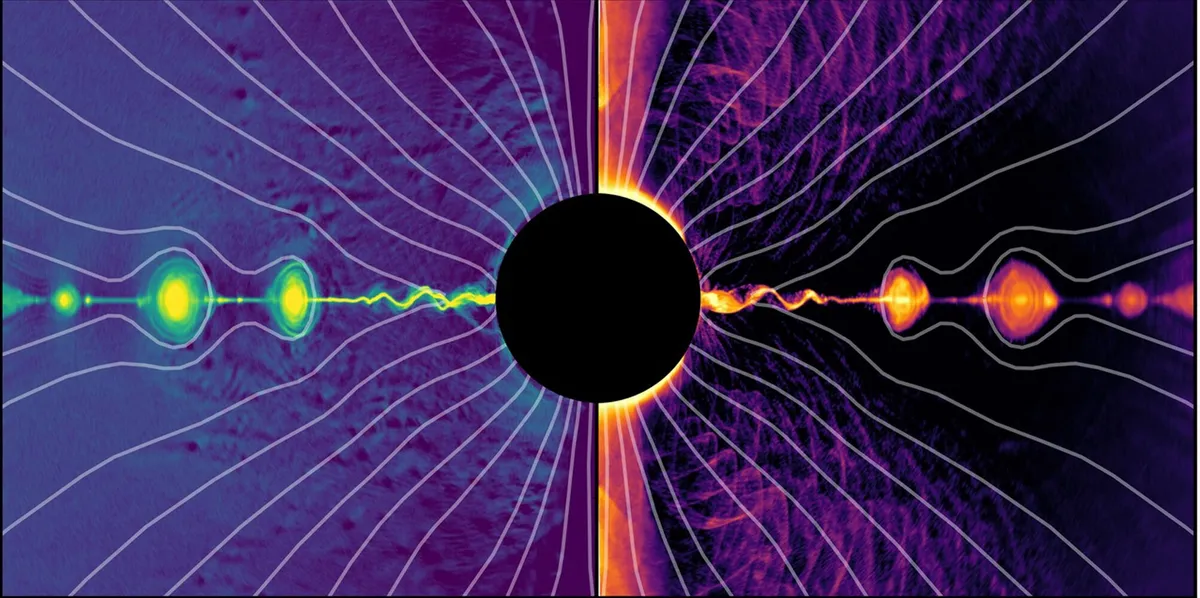
More than a century before the Event Horizon Telescope Collaboration unveiled the groundbreaking first image of a black hole in 2019, astronomer Heber Curtis made a pivotal discovery. In 1918, he observed a peculiar jet emanating from the center of the galaxy M87, which we now know is associated with the black hole designated M87*. These jets are not unique to M87*; they are produced by various other black holes throughout the universe.
Recent research conducted by theoretical astrophysicists at Goethe University Frankfurt has led to the development of a sophisticated numerical code designed to model how black holes convert their rotational energy into these ultra-fast jets. The findings of this research have been published in the Astrophysical Journal Letters.
For nearly 200 years, the bright object in the constellation Virgo, initially documented by Charles Messier in 1781 as “Nebula without stars,” was thought to be a nebula rather than a massive galaxy. This misconception left the peculiar jet discovered in 1918 unexplained. Today, we understand that the giant galaxy M87 houses the black hole M87*, which possesses an astonishing mass of approximately 6.5 billion solar masses and spins rapidly. The energy generated from this rotation powers a particle jet that is expelled at nearly the speed of light, stretching a staggering 5,000 light-years across space.
A team of astrophysicists led by Prof. Luciano Rezzolla has created the Frankfurt Particle-in-Cell code for black hole spacetimes (FPIC). This numerical code provides a highly precise description of how black holes convert their rotational energy into particle jets. The research reveals that, alongside the well-known Blandford–Znajek mechanism, which uses strong magnetic fields to extract energy, another significant process known as magnetic reconnection plays a key role.
Magnetic reconnection occurs when magnetic field lines break apart and then reassemble, transforming magnetic energy into heat, radiation, and plasma eruptions. The FPIC code effectively simulates the behavior of numerous charged particles and extreme electromagnetic fields influenced by the black hole's intense gravitational pull.
Dr. Claudio Meringolo, the primary developer of the FPIC code, emphasizes the importance of simulating these processes to gain insights into the complex dynamics of relativistic plasmas situated in curved spacetime near compact objects. These simulations were computationally intensive, requiring millions of CPU hours on supercomputers in Frankfurt and Stuttgart. Such significant computing power was crucial to solving Maxwell's equations and the motion equations for electrons and positrons based on Einstein's theory of general relativity.
The researchers observed intense reconnection activity in the black hole's equatorial plane, resulting in the formation of a series of plasmoids—condensed plasma in energetic bubbles—propelling themselves at speeds close to that of light. This activity generates particles with negative energy, which contribute to powering extreme astrophysical phenomena, including jets and plasma eruptions.
Dr. Filippo Camilloni, a collaborator on the FPIC project, highlights the significance of their findings, stating that the Blandford–Znajek mechanism is not the sole astrophysical process capable of extracting rotational energy from a black hole. The involvement of magnetic reconnection provides a new avenue for understanding how energy is efficiently harvested from rotating black holes and directed into jets.
Prof. Rezzolla adds, “Our work enables us to explain the extreme luminosities of active galactic nuclei and the acceleration of particles to velocities approaching the speed of light.” He underscores the excitement and importance of utilizing advanced numerical codes to deepen our understanding of the phenomena occurring in proximity to black holes, all while employing rigorous mathematical frameworks to explain the outcomes of these complex simulations.